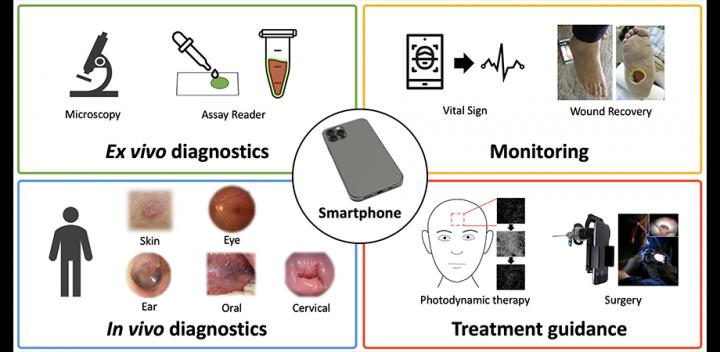Development of smartphone-based imaging systems for medicine and healthcare can be optimized by newly published guidelines for holistic assessment

Credit: Hunt et al., doi 10.1117/1.JBO.26.4.040902
Smartphones get smarter every day. These “Swiss Army knives” of mobile computing become even more useful with specialized attachments and applications to improve healthcare. Based on inherent capabilities like built-in cameras, touchscreens, and 3D sensing, as well wearable peripheral devices, custom interfaces for smartphones can yield portable, user-friendly biomedical imaging systems to guide and facilitate diagnosis and treatment in point-of-care settings.
What are the most effective ways to leverage and augment smartphone capabilities? Helpful guidelines are provided in a critical review of emerging smartphone-based imaging systems recently published in the Journal of Biomedical Optics (JBO).
According to author Brady Hunt, a research scientist at Dartmouth College’s Thayer School of Engineering, “The ubiquity of the smartphone is frequently cited as a justification that smartphone-based systems are inherently low-cost, easy-to-use, and scalable biomedical imaging solutions.” But, as Hunt and his co-authors point out, most systems developed are limited to a single phone model, like an iPhone 12 or the ultra-rugged Caterpillar S61, and involve manual, often fragmented image acquisition and analysis pipelines.
Focusing specifically on live (in vivo) applications for a diverse array of point-of-care-imaging, Hunt and his co-authors survey and assess recent research, identifying numerous design challenges, as well as areas with strong potential. Their focus on real-world usability provides meaningful direction for prospective designers of custom hard- and software for smartphone interfaces. Generally, the most effective use-case scenarios for medically savvy smartphone imaging systems are those in which handheld, noninvasive image guidance is needed and accommodated by the clinical workflow.
Among the top emerging technologies identified for diagnostic and treatment guidance applications are handheld systems for multispectral and quantitative fluorescence imaging. These applications often require embedded electronics to control light delivery, and the authors note that wireless communication to embedded electronics is an underutilized yet promising way to improve and customize control.
Ways to improve
Three high-priority areas are proposed to advance research in smartphone-based imaging systems for healthcare:
- Improved hardware design to accommodate the rapidly changing smartphone ecosystem
- Creation of open-source image acquisition and analysis pipelines
- Adoption of robust calibration techniques to address phone-to-phone variability
Variability among smartphone platforms is a significant problem for reproducibility, which the authors suggest may be addressed by the creation of templates that support the core functionality necessary for biomedical imaging. These platform-specific templates would ideally include support for RAW image acquisition and standardized processing routines for common biomedical image analysis tasks.
As smartphones grow smarter, their built-in capabilities will render them increasingly versatile and better able to contribute to biomedical imaging. Harnessing those smarts to benefit healthcare invites creative, collaborative biomedical engineering.
###
Read the original article by Brady Hunt, Alberto J. Ruiz, and Brian W. Pogue, “Smartphone-based imaging systems for medical applications: a critical review,” J. Biomed. Opt. 26(4) 040902 (2021), doi 10.1117/1.JBO.26.4.040902.
Media Contact
Daneet Steffens
[email protected]
Original Source
https:/
Related Journal Article
http://dx.




